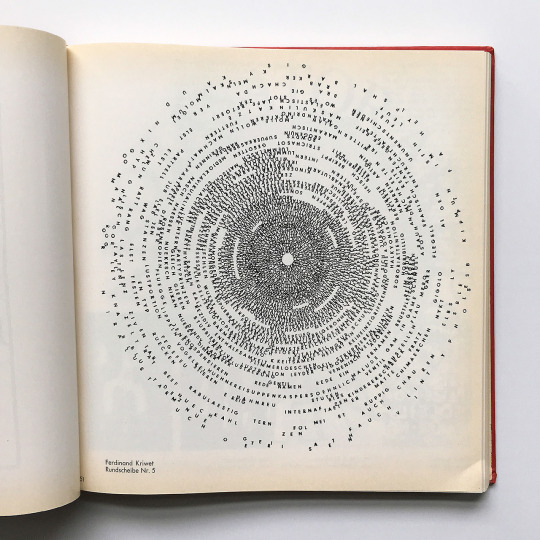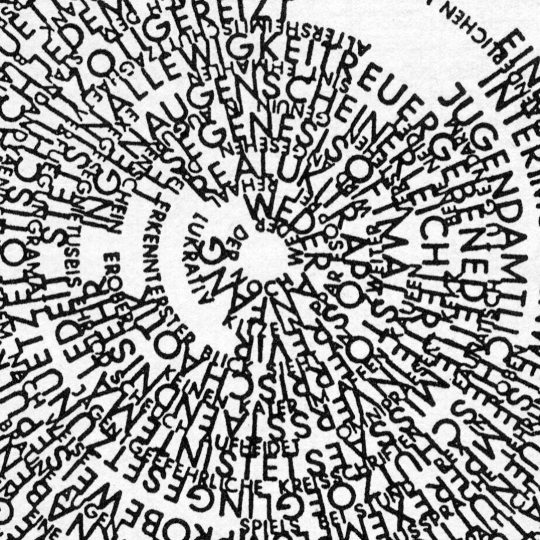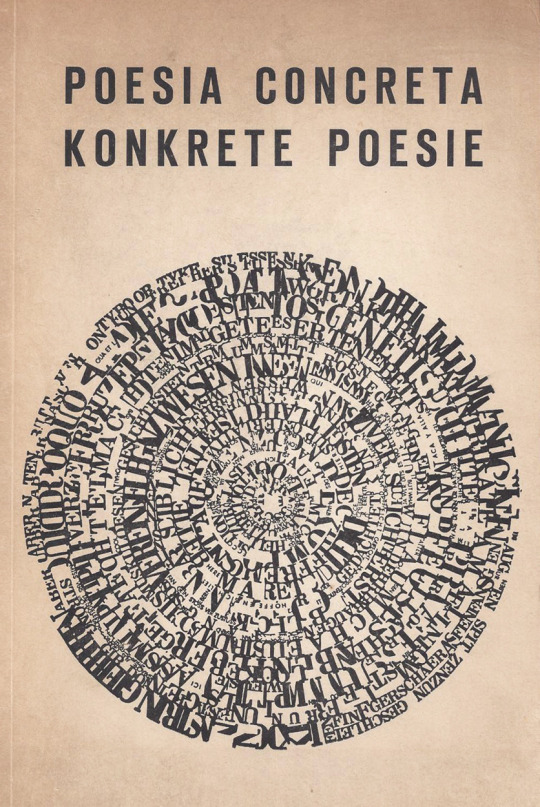#Ferdinand Kriwet
Explore tagged Tumblr posts
Text

Ferdinand Kriwet - Schrift und Bild Schrift en beeld L’art et l’écriture Art and writing, Typos Verlag, Edited by Dietrich Mahlow, Frankfurt am Main, 1963. Design Wolfgang Schmidt. With contributions by Jean Arp, Hugo Ball, Herbert Bayer,
97 notes
·
View notes
Photo


Ferdinand Kriwet. Rundscheibe IX (1962)
157 notes
·
View notes
Text

Fielding Daws - All I Know's What I Hear
Recommended cassette! My friend and neighbor Michael Klausman made this beautifully odd / oddly beautiful sample collage for the great Love All Day label, and I wrote a little blurb to go along with it. Here's the blurb!
Beamed in from Colorado’s Front Range, Fielding Daws’ All I Know’s What I Hear is a sample-based fantasia concocted by poet/publisher/collector/DJ Michael Klausman. It’s a kaleidoscopic affair, drawing inspiration from early primitive loop pieces by J.O. Mallander, Peter Roehr and Ferdinand Kriwet, as well as the ’80s cassette underground. If that all sounds a tad esoteric, have no fear. The album’s primary mode is one of sheer playfulness, as Klausman mixes and mashes an array of divergent sources, some obscure, some very much not obscure, some musical, some speech based. Throughout, he puts wildly different voices in conversation with one another, delighting in the strangely bewitching results, whether it’s the slo-mo soul dream of “You Without You” or the dangerously danceable grooves of “Grown Wheat In Your Null” or the helter-skelter boogie-woogie of “Karot.” There are moments that feel relentlessly repetitive at first blush, but the sounds eventually begin to transform into subtle shapes the deeper you sink into them, uncanny rhythms and occasionally comical juxtapositions emerging at a brisk clip. You can feel the seams in the songs here, the rivets (barely) holding the structure together; these are samples, yeah, but there’s an element of thrilling high-wire performance art, with the lo-fi nature of many of the recordings adding rich, enveloping textures. Mistakes are made, jolting you out of whatever reverie you might have fallen into — and then they’re instantly embraced as part of the process, a necessary breaking of a spell. Listen in, and you’ll hear plenty you didn’t know previously.
2 notes
·
View notes
Photo

Ferdinand Kriwet
Rundscheibe IX, 1962-1963
33 notes
·
View notes
Text

Ferdinand Kriwet, Poesia Concreta / Konkrete Poesie, Goethe-Institut, München, 1974
7 notes
·
View notes
Photo

ferdinand kriwet, button 1c. 1967
3 notes
·
View notes
Photo

Ferdinand Kriwet German, b. 1942), Poem-Painting No. 1, 1964. Acrylic on canvas, 100 x 200 cm.
95 notes
·
View notes
Photo

Thirty-two silkscreened plates of concrete and visual poetry by Herman de Vries, Adriano Spatola, Haroldo de Campos, Timm Ulrichs, Ferdinand Kriwet, Arrigo Lora Totino, Mirella Bentivoglio, Reinhard Dohl, Eugen Gomringer, Hans Clavin, and E. M. de Melo e Castro among others. ‘exempla: documenti di poesia concreta e visuale / documents of concrete and visual poetry’, edited by Maurizio Nannucci, 1970. Edition of 200 housed inside a black paper slipcase and complete with an essay on the evolution of experimental poetry.
#concrete poetry#typography#Black and White#1970#not mine#000#silkscreen#the idea of the book#maurizionannucci#hermandevries#adrianospatola#haroldodecampos#ferdinandkriwet
13 notes
·
View notes
Photo

Ferdinand Kriwet, ZUVERSPAETCETERANDFIGURINNENNENSWERT OLLOS,... https://ift.tt/2FLPXe7
20 notes
·
View notes
Photo

Ferdinand Kriwet
Rundscheibe IX, 1962
https://zkm.de/en/artwork/round-disk-ix
0 notes
Photo

A narrative without punctuation nor page numbers, and without a beginning, middle, nor an end. Ferdinand Kriwet’s ‘Rotor’, published in 1961 at age nineteen. Read more at theideaofthebook.com or DM for information.
#letterforms#graphicdesign#typography#kriwet#ferdinandkriwet#theideaofthebook#artdirection#artistsbook#artbook#1961#bookdesign#köln#design
2 notes
·
View notes
Text
Translation
"Of course we had a Schneewittchensarg" (Schneewittchensarg was a nickname for the Braun SK-4 a radio/turntable combination. It translates to "Snow White's coffin.")
Not much is known about Florian Schneider-Esleben, who died in April 2020. He was the great, silent enigma in Kraftwerk. But his sister Claudia answered some questions about her brother’s musical preferences. Of course, Schneider and Kraftwerk did not only influence dozens of artists, they were also musically inspired themself.
Which part did music play in your home?
Claudia Schneider-Esleben: Our mother discovered Florian’s musical talent when she watched him conduct the music on the radio, when he was two years old. When I was nine years old, I took private piano lessons and Florian learned to play the recorder. At age 13, he got a hand-made silver flute and became the favourite student of the flute player Rosemarie Popp, who brought him to the Robert-Schumann-Konservatorium in Düsseldorf as her most talented student. We played as a duet at our home concerts. When he was 18 years old, Florian often disappeared into the old town, carrying his flute under his arm, into the DumDum, to jam with several jazz musicians including Klaus Doldinger, Albert Mangelsdorff and Peter Brötzmann, later in the Creamcheese with Joseph Beuys and in the Kunsthalle with Ferdinand Kriwet. Until Flo met Ralf Hütter in 1968, at a summer course of the Jazz Festival in Solingen/Remscheid.
Did you have a record player at home?
Of course we had a Schneewittchensarg by Braun standing in our music room, along with a decent record collection, curated by our mother. Her mother, Ursula van Diemen, had been a reputable concert singer in Berlin in the 1920′s. Our father found some records on his travels and added them to the collection. As an architect, he even developed a radiogram in the 50′s which included a radio, a record player and a tape recorder and enabled us to make sound recordings as a family with songs and poems.
What did you play [on the record player]?
On Sundays, our parents liked to listen to the Brandenburg concertos by Bach during brunch, after we visited the catholic mass. We also liked to listen to baroque music as well as Mozart, Chopin and Schumann. But also to Karl Bartok,Olivier Messiaen, Karl-Heinz Stockhausen and Musique Concréte. And records from Marlene Dietrich, Ella Fitzgerald, the Modern Jazz Quartet and Louis Armstron as well as flamenco, gospel, blues, and Indian ragas. Our father brought mariachi music from Mexico with him, rap from New York and a conga from Morocco.
Did you and Florian talk about music a lot?
Music was our constant companion, it was a social kit, rebel, freedom and entertainer. My brother continued the musical education from my early childhood by taking me to concerts of Ravi Shankar, Olivier Messiaen and Thelonious Monk, but also to operas from Beethoven and Wagner. Later we went to concerts of Jimmy Smith, Franz Zappa and Dr. John Babylon in Frankfurt, together with Ralf Hütter. We saw Jimi Hendrix in Düsseldorf. At night, we laid in our beds and listened to LPs by John Coltrane, Sun Ra, Pharoah Sanders, Yussef Lateef and Charles Mingus. Florian studied musicology in Cologne in the early 70′s but he quickly became more interested in Can and his own music, back then produced by Conny Plank.
That are very diverse inspirations
Yes, we were always accompanied by a wild mix of serious music and popular music, from Philip Glass, Terry Riley Steve Reich and Moondog to Ethno from far-away countries like the Gameelan Orchestra from Bali and Le Mystère des Voix Bulgares. What followed were musicians like Stevie Wonder, Herbie Mann and James Brown, then bands like the Beach Boys, Grateful Dead, Average White Band and Jefferson Airplane. Later stuff like Velvet Underground, John Cale and Iggy Pop, Blondie, the Talking Heads and Patti Smith. Then synthie pop came into play more. Eurythmics, Ultravox, Brian Eno and David Bowie, Madonna, Michael Jackson and Prince. It also got broader later from Hip Hop with Afrika Bambaata, Snoop Dogg or Jay-Z to the Kronos Quartett, Giorgio Moroder, Señor Coconut and Pharrell Williams. And when Florian was teaching Digital Composition at the HfG in Karlsruhe, the “electonic Bauhaus”, he visited Oskar Sala in Berlin with his students.

Claudia posted the interview with her from that new KW magazine and honestly... I love this tbh
#kraftwerk#wait so Flori DID teach in Karlsruhe?#The HfG said he never took their offer#I even walked past that building once!#And Flori listened to Jay-Z?#Imagine him vibing to 99 Problems!
17 notes
·
View notes
Photo

First published by the legendary Something Else Press in 1967, An Anthology of Concrete Poetry was the first American anthology on the international movement of Concrete poetry. The movement itself began in the early 1950s, in Germany–through Eugen Gomringer, who borrowed the term “concrete” from the art of his mentor, Max Bill–and in Brazil, through the Noigandres group, which included the de Campos brothers and Decio Pignatari. Over the course of the 1960s it exploded across Europe, America and Japan, as other protagonists of the movement emerged, such as Dieter Roth, Öyvind Fahlström, Ernst Jandl, bpNichol, Mary Ellen Solt, Jackson Mac Low, Ian Hamilton Finlay, Bob Cobbing, Dom Sylvester Houédard, Pierre Garnier, Henri Chopin, Brion Gysin and Kitasono Katue. By the late 1960s, poet Jonathan Williams could proclaim: “If there is such a thing as a worldwide movement in the art of poetry, Concrete is it.” The work of the 77 writers collected in this anthology varies greatly in its aims and forms, but all can be said to emphasize the visual dimension of language, manipulating individual letters and minimal semantic units to produce poems that are for contemplating as much as for reading. Emmett Williams, the book’s editor, added explanatory commentary for the poems and biographies of their authors, making this volume–long out of print–the definitive anthology of this movement, which has so influenced artists and writers of subsequent generations.
Writers and artists included: Friedrich Achleitner, Alain Arias-Misson, H. C. Artmann, Ronaldo Azeredo, Stephen Bann, Carlo Belloli, Max Bense, Edgard Braga, Claus Bremer, Augusto de Campos, Haroldo de Campos, Henri Chopin, Carl Friedrich Claus, Bob Cobbing, Paul de Vree, Reinhard Döhl, Torsten Ekbom, Öyvind Fahlström, Carl Fernbach-Flarsheim, Ian Hamilton Finlay, Larry Freifeld, John Furnival, Heinz Gappmayr, Ilse and Pierre Garnier, Matthias Goeritz, Eugen Gomringer, Ludwig Gosewitz, Bohumila Grögerova and Josef Hiršal, José Lino Grünewald, Brion Gysin, Al Hansen, Václav Havel, Helmut Heissenbüttel, Åke Hodell, Dom Sylvester Houédard, Ernst Jandl, Bengt Emil Johnson, Ronald Johnson, Hiro Kamimura, Kitasono Katue, Jiri Kolar, Ferdinand Kriwet, Arrigo Lora-Totino, Jackson Mac Low, Hansjörg Mayer, Cavan McCarthy, Franz Mon, Edwin Morgan, Maurizio Nannucci, bp Nichol, Hans-Jørgen Nielsen, Seiichi Niikuni, Ladislav Novák, Yuksel Pazarkaya, Décio Pignatari, Vlademir Dias Pino, Luiz Angelo Pinto, Carl Fredrik Reuterswärd, Diter Rot, Gerhard Rühm, Aram Saroyan, John J. Sharkey, Edward Lucie Smith, Mary Ellen Solt, Adriano Spatola, Daniel Spoerri, Vagn Steen, Andre Thomkins, Enrique Uribe Valdivielso, Franz Van Der Linde, Franco Verdi, Emmett Williams, Jonathan Williams, Pedro Xisto and Fujitomi Yasuo.
2 notes
·
View notes


